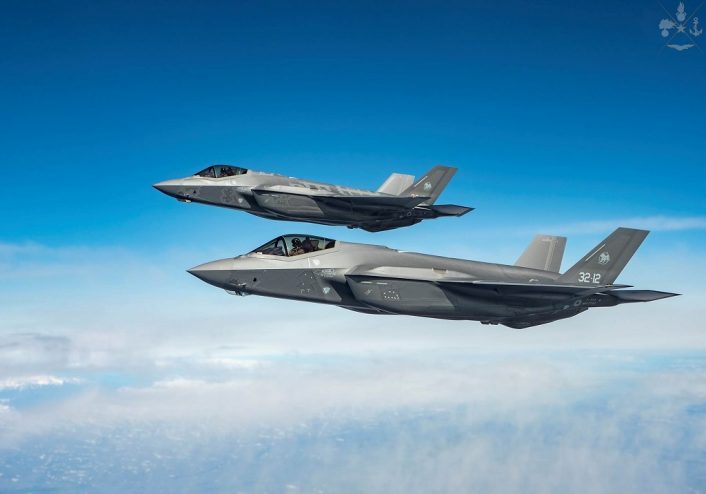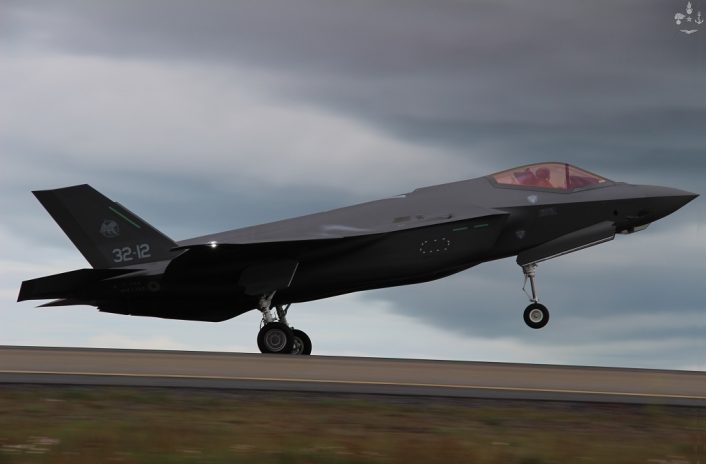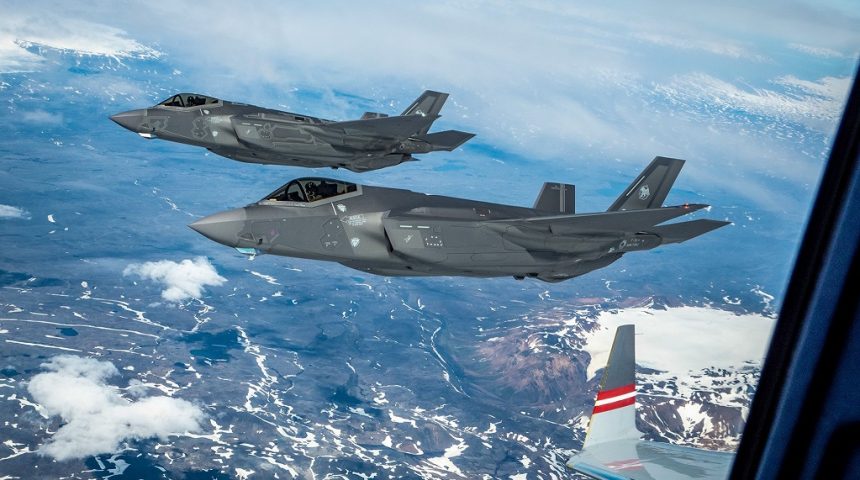The new coating was already applied to US-built aircraft since 2017, but this seems to be the first time it’s applied to aircraft assembled internationally.
As you may already know, six Italian Air Force’s F-35As are currently deployed in Iceland for the second time in support of NATO Icelandic Air Policing. A few days ago, two F-35s performed a Tango Scramble (or Training Scramble) to intercept a Challenger CL-604 of the Royal Danish Air Force (RDAF) on its way to Greenland, which acted as a “zombie” for this training mission. “Zombie” is the term used by Quick Reaction Alert pilots to refer to the unidentified aircraft that they are going to intercept.
The RDAF later posted a photo of the two fighter jets flying in formation with the Challenger at the end of the training event on their social media channels. What’s interesting about this photo is that we can see side by side both the new and the old coating of the F-35. To be more precise, the aircraft in the background is the one with the older livery, while the other one in the foreground is the F-35 with the new livery.
The aircraft with the new livery is the F-35A with construction number AL-12 / serial MM7362 and coded 32-12, the latest delivered to the 32° Stormo (Wing), the unit which operates the Lightning II in the Italian Air Force, and the first one to wear the new livery.
Actually, this new livery has been around already for some time with F-35s from other countries but this is the first time that it was applied to an Italian aircraft.

The old livery presented very evident panel lines which were painted a lighter gray than the rest of the aircraft, resulting in the characteristic saw tooth panel lines above and on the sides of the fuselage. In a weekly update by Lockheed Martin’s General Manager Jeff Babione dated April 13, 2017, the new coating system was announced as able to cut-off 128 hours in the painting process, resulting in a reduction of the costs by USD 16,000 per aircraft and 49M USD in the total life of the Joint Strike Fighter program.
Here is an extract of the aforementioned update:
Through a new coating system, the team was able to give the F-35 one uniform coat that saved a significant number of hours per unit in defects and rework.
James Thistle was the first to suggest the new coatings, now referred to as the Z13 overcoat. It took five years and a lot of hard work to incorporate the new coatings. The team used AF104 as a trial run with no issues, and James said it was worth the wait.
The Z13 overcoat significantly reduces the need for many of the labor-intensive tasks that drove rework and repair hours up.
The mentioned F-35 with construction number AF104 received USAF serial 14-5103 and is currently the flagship bird of the 56th Operations Group at Luke Air Force Base in Arizona.

Another article which is not available online anymore on official websites, but is quoted in multiple aviation forums, features some more details from Mr. Thistle himself, at that time the Production Operations Senior Manager in Aircraft Final Finishes (AFF): “The Aircraft Finishes configuration required the preparation and applications of various materials, which aesthetically appear as jig saw panes of various shades of gray across doors, panels and control surface edges. The manufacturing process to yield a complying product are extremely labor intensive and requires unique skill sets and more so concentrated attention to detail, which meant more labor and processing span in AFF. Despite the immense efforts amongst the F-35 Finishes organizations, the process often yielded escapes and as a result contributed towards the organizations number one driver for quality defects.”
The article goes on also by stating that the older livery required workers to hand spray various coat materials and this has now been replaced by robotic systems: “The idea to optimize the process by eliminating multiple masking operations and the need to manually hand spray various top coats by using robotic application during the final top coat application; or “Z13” overcoat as it is more commonly known, was conceived. The project will reduce the cost of an F-35A by $16,000 per aircraft and will save $49 million in the total life of the program.”
This change of the coating system was reported to be in effect since 2017 in the U.S. production lines, while for the Final Assembly and Checkout (FACO) plants outside of the U.S. this may have taken some more time. Currently, the F-35s which were painted with the older coating system are still flying wearing the same livery, but it is reasonable to think that they will receive the new coating when they will undergo heavy depot level maintenance in the next years.









